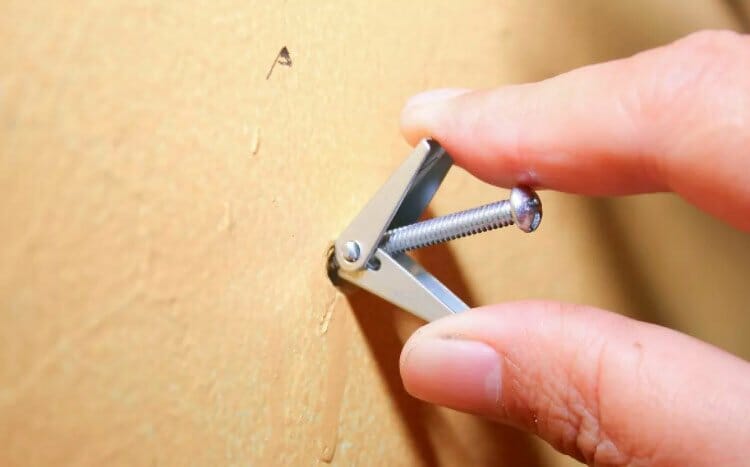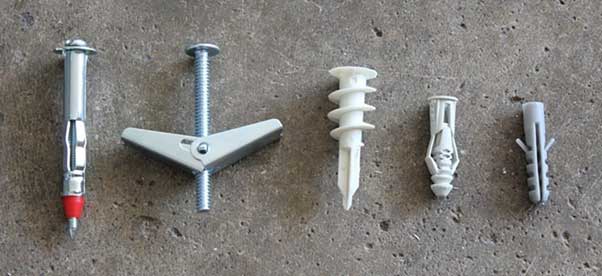Prior to mounting a painting or setting up a new flat-screen TV in your living area, it’s crucial to assess your drywall’s ability to support weight.
The average ½ inch drywall can safely hold up to 60 pounds with a typical drywall screw mount. If you are able to find a timber stud behind the drywall and hang from that, you will be able to safely hang closer to 100 pounds.
The amount of weight you can be able to hold on a drywall will depend on the thickness of the drywall you use and the mounting hardware. Below is some detailed weight data.
| Drywall Thickness | Mount Type | Maximum Weight |
|---|---|---|
| 1/2 inch | Drywall Screw | 18 pound |
| 5/8 inch | Drywall Screw | 25 pound |
| 3/8 inch | Drywall Screw | 32 pound |
| 1/2 inch | Toggle Bolt | 20 pound |
| 5/8 inch | Toggle Bolt | 50 pound |
| 3/8 inch | Toggle Bolt | 100 pound |

How much a drywall ceiling can hold
Most drywall ceilings with ½ inch thickness can hold an average of 18 pounds regardless of the kind of hanging hardware you use. They can however only hold a maximum of 15 pounds for moving fittings which generally exert a greater downward pull.
How much weight can a drywall hold per square foot?
A drywall can only hold as much weight as its thickness allows. This, therefore, means that an average ½ inch of drywall can be able to hold a weight of between 1 to 2 pounds relative to its thickness. A 5/8-inch drywall which is a bit thicker can hold an average of 1.8 pounds per square foot.
How much weight can a drywall hold without a stud?
Where the reinforcement offered by studs is absent, drywalls can only hold between 2.5 and 5 kilograms. In such scenarios, only extremely light items should be hanged on the said wall.
How much weight can a screw hold drywall?
Generally, screws can only hold up to 10 pounds of weight when drilled into drywall. This is because of the rather flaky nature of drywall which can result in it breaking apart if heavier articles are attached to it. This flaky and light nature also makes it easier for drywalls to be installed over old paneling for a fresher look in any given space.
Which hanging hardware should I use?
Hanging hardware varies from space to space. Consulting various drywall experts is therefore the recommended way of finding the best hanging hardware for your space.
Home Garden Guides is a great tool that quickly matches you with the best drywall specialists in your locality. You can get three estimates from local drywall professionals in a matter of two minutes. Kindly follow the steps below to enjoy this great service:
- Scroll to the top of the page and enter your zip code
- Answer questions about your drywall job
- Your drywall repair details are forwarded to three local experts who will send you a price estimate for your job with some friendly advice
Hanging hardware is essential when looking to hang items on studs. It is therefore important for people to understand how to use the various kinds of hanging hardware which include:

Screw-in Anchors
Screw-in anchors are by far the most common fasteners as far as drywall anchoring is concerned. This is because they can be able to hold up light and medium-weight items which are quite popular in spaces made up of drywalls. They are generally available in both metal and plastic material
Nails and Picture-Frame Hangers
These are normally available in different shapes and sizes. They are often used to hoist up souvenirs which are either medium or heavy in terms of weight. This generally consists of loads which are between 25 to 50 pounds. Examples include angled nails and flat-mounted hooks.
Toggle Bolts
Toggle bolts are usually available in both plastic and metal versions. The metal versions are generally the go-to fasteners as far as heavy loads weighing about 50 pounds are concerned. Plastic toggle bolts on the other hand are generally specialized to support loads of medium weight
How much weight can drywall hold: with and without anchors?
Drywalls can generally hold a maximum of 10 pounds per time without anchors. Their flaky and brittle nature does not allow them to carry a lot of weight. This in turn means that they may require either repair or replacement if damaged by excessive weight.
Anchors, therefore, help drywalls to support more weight. Small anchors can support up to 18 pounds while medium anchors are able to hold up to a maximum of 25 pounds. It is however important to note that each anchor is usually applied based on the thickness of the drywall in question.
How much can a 2x4 stud support?
Vertically a 2 by 4 stud can support an average weight of 1000 pounds, especially in situations where the load is flat against the wall. This means that it supports an average of 100 pounds per square foot. This is however heavily dependent on the length of the wall as well as the strength of the wind blowing against it.
The benefits of using studs over drywall to hang items.
The major benefit derived from using studs instead of drywalls to hang items is certainly support. In other words, studs are sure to offer greater stability in terms of securing fasteners such as nails which are used to hold up a wide variety of items.
What are the best drywall anchors?
The suitability of drywall anchors usually depends on a variety of factors such as wall thickness and item weight, shape, and size. Plastic sleeves, screw-in, and tap-in anchors are generally suitable for supporting light and medium loads weighing between 10 to 25 pounds.
Heavier loads weighing up to 50 pounds usually require flat-mounted hooks, molly bolts, toggle bolts, and hollow-core door anchors to effectively and securely hold them up.
Should I attach to studs behind drywall?
Various art pieces can be attached to drywall either with or without studs. This basically means that one can be able to decorate any given space with pictures and items without the use of studs. Studs are however recommended when looking to obtain an extra layer of reinforcement.
Effective utilization of studs
Studs are sections of wood that are generally located beneath the drywall. These wooden pieces which are vertically fitted and spaced usually function as the frame of the said drywall. They give greater support by providing a stable base on which nails and screws can be attached.
Finding a stud
There is a wide range of ways and techniques which can be utilized when looking to find a stud. These include:
Using Electrical Outlets
Most electrical outlets including switches and sockets are usually attached to studs during the process of fitting. Locating them can therefore function as a certain strategy for finding studs. The only thing required when using this method is to find out whether there is a vertical beam located behind the outlet in question.
This is usually done by temporarily removing the outlet from the section on the wall to which it has been attached. Finding one stud is all that is required to be able to locate the other. This is because studs are generally spaced evenly in either 16 or 24-inch intervals depending on the room under consideration.
Using stud finders
Stud finders typically function using either electronic or magnetic-type sensors. Electronic stud finders are battery powered which essentially means that their sensors, audible signals, and visual displays generally function on cell-produced power. They identify studs by analyzing the density changes that exist beneath the plane undergoing scanning.
Magnetic stud finders are normally cheaper than their electronic counterparts since they have a shallower sense component. They work by utilizing the rare earth magnets in their makeup to identify the metal fasteners providing support to the studs. They are however not able to accurately detect the stud edges as a result of their shallow penetration.
Knocking
Knocking is usually used to locate studs when both stud finders and electrical outlets are unavailable. Its manual nature means that the people knocking need to be extremely certain of the sound they are hearing lest they attempt to plug in a nail where no stud exists.
A hollow knock is normally an indication that there is no stud underneath the surface in question. A heavy and stifle knock on the other hand is generally a sign that there is a stud beneath the said wall.
Conclusion
There is a wide range of factors that need to be considered before deciding whether to hang any given article on a drywall. Objects should therefore only be attached to drywalls in cases where prerequisites such as quality fasteners and studs have been put into consideration.
The balance between great designs and the safety of items should also be adhered to when looking to come up with a space that is both secure and creative.








